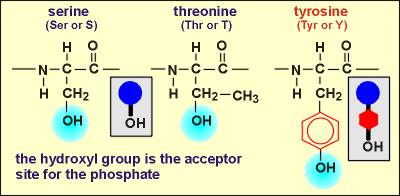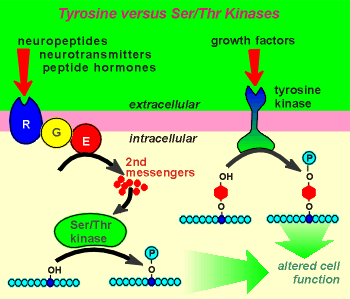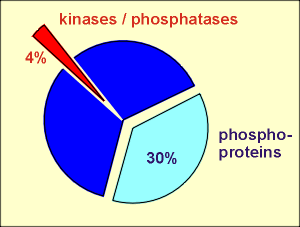
Kinases are enzymes which catalyze the phosphorylation of
proteins. They do so on hydroxyl groups on the side chains of amino acids within the
protein structure.
ATP is the phosphate donor in this enzymatic reaction and ADP is generated in the process.
The substrate proteins for the kinases are often other enzymes.
Phosphorylation of the enzymes affects enzymatic activity.
For some enzymes phosphorylation leads to an activation; for others, it leads to inactivation.
By regulating the functioning of enzymes and other proteins in the cell the kinases are very important in regulating cellular events.
 There are three amino acids which possess hydroxyl side chain groups required
for phosphorylation.
There are three amino acids which possess hydroxyl side chain groups required
for phosphorylation.
These are Serine, Threonine and Tyrosine.
The structures of these three amino acids are shown on the left, together with their official three letter codes (Ser, Thr and Tyr) and single letter codes (S, T and Y).
Shown in the inserts are the symbolic representation for Ser/Thr and Tyr that will be used in a number of illustrations in this tutorial.
There are two major classes of kinases, those that phosphorylate serine and threonine and those that phosphorylate tyrosine.
The former are called Ser/Thr Kinases and the  latter
are called Tyrosine Kinases.
latter
are called Tyrosine Kinases.
The two classes of kinases differ both with respect to where they are found in a cell and how they are activated.
The Ser/Thr kinases are found in the cytoplasm of the cell.
They are activated by second messengers (e.g. cyclic AMP, diacylglycerol).
These second messengers are generated by enzymes (E) regulated by G proteins (G).
The G proteins in turn are activated by receptors (R) for neurotransmitters and neuropeptides.
Thus, Ser/Thr kinases are an important element in "G protein coupled receptor signaling".
Concerning the tyrosine kinases, there are two types, namely tyrosine kinase receptors and non-receptor tyrosine kinases.
This tutorial concerns the former type.
Most tryrosine kinases are in fact of the receptor protein type.
They are found on the membrane of the cell (see figure) and are directly activated by extracellular messengers.
The most common type of ligand for the tyrosine kinase receptors (TKRs) are growth factors such as platelet derived growth factor (PDGF), epidermal growth factor (EGF) and insulin-like growth factors.
As well there are a number of brain specific growth factors which function through tyrosine kinase receptors.
The receptor for the hormone insulin is also a tryrosine kinase.
As mentioned earlier, the kinases (both Ser/Thr and TKRs) phosphorylate intracellular proteins which are often enzymes and thus bring about changes in cell function.
To the left is a movie that illustrates the phosphorylation of protein substrate by a kinase.
The part of the kinase containing the ATP-binding site and the substrate binding domain is shown.
The ATP-binding site holds the ATP in the correct orientation so that one of the high energy phosphate groups (the gamma phosphate group) can be transferred to the hydroxyl group of an amino acid (serine, threonine or tyrosine) within the substrate.
In the process ADP is produced which subsequently leaves the kinases.
Another ATP is then free bind to the ATP site and the kinase is ready for the next phosphorylation.
 Protein phosphorylation-dephosphorylation is probably the most crucial
chemical reaction taking place in living organisms.
Protein phosphorylation-dephosphorylation is probably the most crucial
chemical reaction taking place in living organisms.
It is the basis for the control of many diverse biological events triggered by extracellular effectors such as hormones and neurotransmitters.
It has been estimated that 30% of intracellular proteins are phosphoproteins and about 4% of the proteins encoded for by the eukaryotic genome are protein kinases and phosphatases.
The latter enzymes remove phospho-groups from proteins and are thus also important in the regulation of the protein phosphorylation-dephosphorylation cycle (see movie to the right).
*******
Among the kinases, the tyrosine kinases are crucial elements in signal transduction pathways that regulate metabolism, gene expression and cell division.
They are of critical importance in the regulation of brain development and differentiation and, in the adult brain are involved in regulating learning and memory processes.